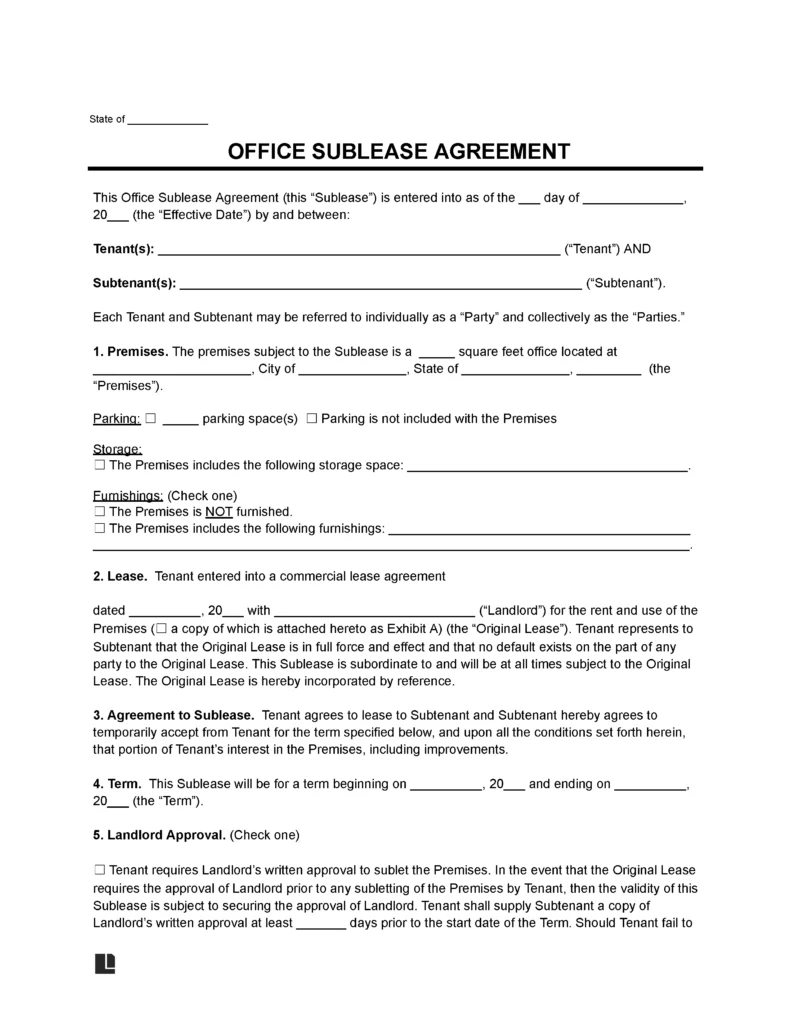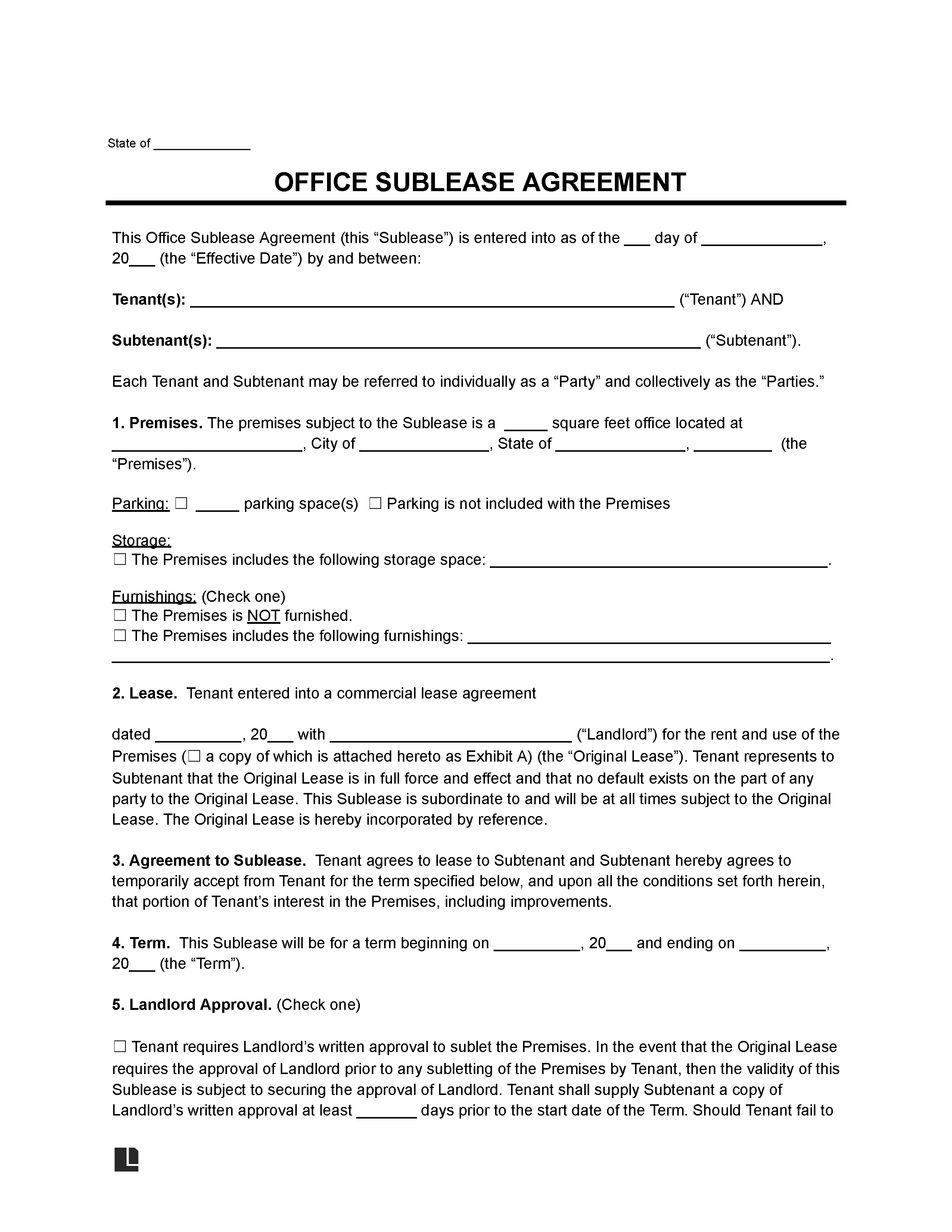An office sublease agreement is a contract in which a tenant subleases all or part of their rented office space to a subtenant. This agreement is distinct from the original lease agreement, but the tenant remains legally responsible to the landlord under the original lease.
The sublease involves three key players: the tenant (sublessor), the subtenant, and the landlord. Subleasing can be beneficial when the current tenant no longer needs the full office space or wants to offset rental costs.
Key Elements of an Office Sublease Agreement
To create a solid office sublease agreement, it’s important to include the following critical elements:
- Description of the Office Space: Clearly identify the space being subleased.
- Sublease Duration: Specify the start and end dates of the sublease.
- Rent Payment and Additional Costs: Detail the rent, payment schedule, and any additional costs, such as utilities.
- Rights and Responsibilities of Each Party: Clarify the obligations of the sublessor, subtenant, and landlord.
- Conditions for Termination: Set terms under which the sublease may be terminated early.
Pros and Cons of Subleasing Office Space
Pros:
- Cost Savings: Subleasing allows tenants to reduce their rental expenses.
- Flexible Terms: Subleases often offer more flexibility in terms of lease duration.
- Efficient Use of Space: Tenants can maximize unused space while subtenants get access to office space without committing to a long-term lease.
Cons:
- Liability: The original tenant remains liable to the landlord for rent and property damage.
- Subtenant Risk: If the subtenant defaults or violates the lease, the original tenant may be held responsible.
How to Fill Out an Office Sublease Agreement
Filling out an office sublease agreement involves providing critical details to ensure all parties involved are legally protected. Here’s a step-by-step guide:
1. Basic Information
- State: Enter the state where the sublease agreement is being executed.
- Effective Date: Fill in the day, month, and year when the sublease agreement will take effect.
- Tenant and Subtenant Names: Include the full legal names of both the tenant (original leaseholder) and the subtenant (new lessee).
2. Premises Description
- Square Footage and Address: Enter the total square footage of the office space being subleased and the full address of the premises.
- Parking: Indicate whether parking spaces are included. Specify the number of spaces, or check “Parking is not included” if applicable.
- Storage: State if storage space is included in the sublease and describe it.
- Furnishings: Specify whether the premises will be rented with furnishings.
3. Original Lease Information
- Lease Date and Landlord Name: Enter the date of the original lease and the name of the landlord.
- Attach a Copy: If required, check the box to attach a copy of the original lease as “Exhibit A.”
4. Sublease Term
- Start and End Date: Fill in the start and end dates of the sublease term.
5. Landlord Approval
- Check the appropriate box based on whether the landlord’s written approval is required. If required, fill in the number of days the tenant has to provide the subtenant with this approval before the sublease term starts.
6. Rent Payment
- Total Rent for the Term: Enter the total sum of rent the subtenant will pay for the entire term.
- Monthly Installments: Specify the monthly rent amount and the due date for each payment.
- Payment Methods: Check the appropriate box for how rent will be paid (e.g., cash, check, electronic transfer).
- Proration: If rent is to be prorated for the first or last month, specify the prorated amount.
7. Late Fees
- Choose whether late fees will be charged. If applicable, provide the number of days after the due date when rent is considered late and the fee amount or percentage.
8. Utilities
- List all utilities and services the subtenant is responsible for and those that will be covered by the landlord (e.g., electric, gas, internet).
9. Security Deposit
- Amount: Enter the security deposit amount the subtenant must pay upon signing.
- Interest: Specify whether the deposit will bear interest.
- Refund Policy: Include the number of days after the termination of the sublease when the security deposit will be returned, minus any deductions for damages.
10. Inspection Checklist
- If an inspection checklist is required, ensure it is attached as Exhibit B and completed within a certain number of days after the subtenant takes possession.
11. Assignment or Subletting
- Choose whether the subtenant can further sublet or assign their rights, with or without written consent.
12. Notices
- Provide the names and addresses of both the tenant and subtenant for the delivery of formal notices under the agreement.
Common Mistakes to Avoid When Subleasing
Avoid these common pitfalls in subleasing:
- Ignoring the Original Lease: Ensure the sublease complies with the terms of the original lease.
- Not Getting Landlord Consent (If Required): Failing to secure the landlord’s approval to sublease, if required by the lease agreement, can lead to the sublease being invalid.
- Inadequate Terms: Using a poorly drafted sublease agreement can leave both parties vulnerable to legal and financial risks.
Office Sublease Agreement Sample
Download a free office sublease agreement template in PDF or Word format:


